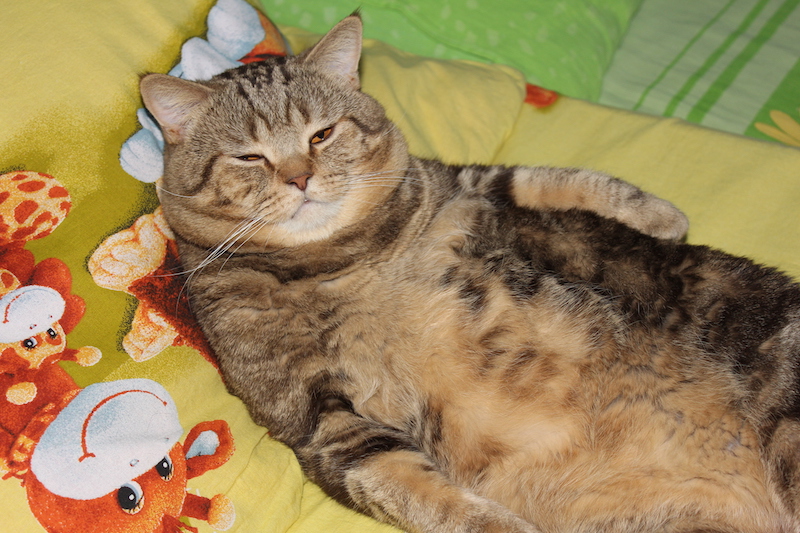American Cats Are Too Fat — But This Diet Can Help

Fat cats may make the internet a merrier place, but it comes at the expense of their own health.
Nearly 60 percent of American cats may be overweight or obese, according to a 2016 survey by the Association for Pet Obesity Prevention, and this excess weight can lead to a number of health problems (including diabetes, skeletal stress and reduced life expectancy) that are reversible with weight loss.
But if you've tried to get your house cat to shed a few pounds, you'll know how challenging it can be. [10 Weird Cat Behaviors Explained By Science]
Indeed, one common feline health challenge is that house cats don't get much exercise, and a one-time reduction to kitty's daily diet might not go far enough to improve its health, according to a new study published in the February 2018 edition of the American Journal of Veterinary Research.
In the study, researchers from the University of Illinois tested a new feline diet that reduced the body weight of eight overweight cats to healthy levels over the course of 18 weeks by gradually reducing each cat's food intake for eight consecutive weeks.
"The intent with this diet was a healthy weight loss: getting rid of fat while maintaining lean mass," study author Kelly Swanson, a professor of animal and nutritional sciencesat the University of Illinois, said in a statement. "The risk with rapid weight loss, especially in a cat, is hepatic lipidosis. The body releases too much fat, and the liver gets bogged down… We targeted a 1.5 percent body weight loss per week, which falls in line with the range (0.5-2 percent per week) suggested by the American Animal Hospital Association."
The eight participating cats — all neutered males — lived together in a large room for the duration of the study, only returning to their individual cages at feeding time. Researchers monitored each cat's health closely. They looked specifically at body weight, physical activity, gut bacteria, blood biochemistry and "body condition score" (BCS), which was measured on a 9-point scale. An animal with a high BCS of 8 or 9 might look "like a little blimp," Swanson said, and animals with a low BCS could be emaciated and malnourished. The cats began the study with an average BCS of 7.5 (ranging from 6 to 9), which researchers aimed to bring down to an "ideal" BCS of 5.
Sign up for the Live Science daily newsletter now
Get the world’s most fascinating discoveries delivered straight to your inbox.
"Each unit increase in BCS above [5] represents approximately 10 percent to 15 percent over ideal body weight," the study said. A cat that weighs more than 20 percent over its ideal body weight is considered obese, the researchers added.
After four weeks of eating a high-fiber, moderate-protein baseline diet, the cats' first calorie cut kicked in. In week one of the 18-week dieting period, the cats had their food intake cut by 20 percent — the maximum amount recommended for weight loss by the American Animal Hospital Association, the study said. Each cat's food intake was reduced further at the beginning of weeks two through eight, and then remained unchanged for the remaining 10 weeks. This persistent food reduction, Swanson said, was the key to meeting each week's weight loss goals.
"When we go on a diet ourselves, we might lose a lot of weight in the first few weeks and then hit a road block," Swanson said. "Same with these animals. We had to keep going down, but it can be hard to convince a pet owner to do that. You might get owners to reduce intake from 60 to 50 grams per day, but we're telling them they might have to go to 45 or 40 grams. We got really low, but we were monitoring them so they were healthy."
By the end of the study, the cats had registered a significant decrease in body weight, BCS score (down to a median score of 6), body fat percentage (down from a mean of 41 percent to 31 percent) and concentration of triglycerides — a type of fat that can increase the risk of stroke and heart attack. There was no significant change in the cats' activity levels, the study noted, perhaps as a reminder that cats will be cats no matter what they eat.
Originally published on Live Science.

Brandon is the space/physics editor at Live Science. His writing has appeared in The Washington Post, Reader's Digest, CBS.com, the Richard Dawkins Foundation website and other outlets. He holds a bachelor's degree in creative writing from the University of Arizona, with minors in journalism and media arts. He enjoys writing most about space, geoscience and the mysteries of the universe.









